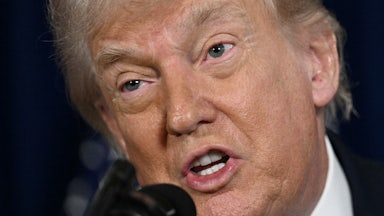With five months until the midterm elections, there has been a sudden surge of interest in the Democratic Party’s “messaging problem.” As you might recall, this was supposed to be a done deal: As Democratic Congressional Campaign Committee executive director Tim Persico told Politico last August, as his party’s polling numbers were starting to slip, “Everything we are doing and everything we’ve talked about doing is incredibly popular.” The DCCC was apparently planning a “messaging blitz” to get the word out. Then Democrats spent months doing none of the incredibly popular things that they’d talked about doing. So what now?
As TNR editor Michael Tomasky pointed out this week, Democratic Party messaging is hard to love. But compared to Republicans, Democrats also face higher hurdles. What Democrats want to do with the government is less suited to a bumper sticker than the GOP’s goals. Plus, they have to convince more self-described independents to buy in than Republicans do. Moreover, as Tomasky points out, the GOP is far defter at naming enemies; Democrats prefer aspiration to confrontation, and this makes it harder to resonate in a media ecosystem that prefers hyping up the conflict of the day to spreading the good word about Biden’s latest op-ed about inflation.
A good message for Democrats would be simple, accessible to broad audiences, optimistic in nature, and capable of blending the aspirations at the core of their politics with a desire to both name and defeat real enemies of progress. So here’s a thought: Democrats should fashion themselves as the providers and defenders of “the Good Life.” I’m borrowing this idea from twentieth-century economist John Maynard Keynes, who believed that the whole point of economic activity was “to bring society to a position where the good life could be enjoyed.” (It should be noted that Keynes was an upper-crust bon vivant whose own concept of the Good Life involved “time for … the contemplation of beautiful objects”—putting him at something of a remove from our society and its immediate needs.)
What are the ingredients of the Good Life? More shared prosperity to reduce economic inequality; more widely distributed political power so that people have more control over their own lives; more political stability to keep upheaval at bay; and, most important of all, more time with the people we love. After all, what are we all living and working for, if not for the chance to spend more of our lives with the people who mean the most to us?
These things are all worth fighting for, and they should fit at the core of what the Democratic Party professes to be: the party of the little guy; a party that will fight to get you more prosperity, power, stability, and time. Perhaps more importantly, this mission involves recovering something that’s been taken from us. As TNR’s Tim Noah reported last year, after the long postwar period in which the Keynesian ideal of incomes keeping pace with economic growth held, a less just economy, fashioned from less just policy choices, emerged four decades ago, causing inequality to bloom and widen to the dire state it is now. A Rand Corporation study depicted the parallel universe we’d be living in had corporate and plutocratic interests not gained the upper hand—median incomes for all but the richest would be substantially higher than they currently are. The Good Life was stolen.
Democrats should be champing at the bit to steal it back; it’s a just cause with worthy enemies. And it’s easy to frame the GOP as the enemy of the Good Life. It has no interest in solving problems and no governing philosophy beyond padding the incomes of the rich and deregulating the world we live in. What is a polluter, after all, other than an economic burden ordinary Americans must bear in a deregulated world? What better reason to reform our health care system than to grab back the precious time of our beloved elders to spend with their grandkids, instead of fighting on the phone over health care billing? What better reason to put an end to the political violence of right-wing thugs than to keep chaos and instability at bay? The fight for the Good Life is an interchangeable mission that works on all fronts for a better world.
The Good Life is also a useful framework for the Democratic Party to renew its relationships with the multitudes beyond well-heeled, college-educated voters. Across the country, millions of Americans have their own concept of the Good Life, and not everyone aspires to be a member of the professional knowledge class. Democrats have an opportunity to think more expansively about our citizens and forge relationships outside of the elite circles in which they’re presently stuck—all without sacrificing core values.
It’s probably too late to turn this into a “winning midterm message.” But there are more elections ahead, along with more threats to shared prosperity, power, dignity, and stability—more thieves of our precious time stalking the landscape. And the struggle against right-wing authoritarianism—which, it’s worth noting, was also a preeminent concern for Keynes—is more critical than ever. The fight for the Good Life is timely and features worthy enemies; it’s a cause that’s accessible and relatable to more people than currently reside in the Democrats’ coalition. And on a long enough timeline, the “message” becomes a simple one: I am on your team. I will fight for the Good Life you’re owed. I will punish the people who stole it from you.










